Detailed Financial System Analysis Report: Tesco's Operations
VerifiedAdded on 2020/01/21
|14
|4554
|294
Report
AI Summary
This report provides a comprehensive analysis of Tesco's financial system. It begins with an introduction outlining the importance of financial systems and the context of Tesco, a major UK retailer operating globally. The report then delves into the purpose and use of various accounting records like journals, ledgers, trial balances, income statements, and balance sheets. It assesses fundamental accounting concepts such as accrual, going concern, prudence, and consistency, and evaluates factors influencing Tesco's accounting system, including capital markets, business entity type, legal regulations, and business size. The report further identifies business risks associated with strategic moves, particularly the risk of fraud, financial risks, changing customer preferences, and increased global competition. It analyzes control systems for fraud detection, specifically in the payroll system, and evaluates related risks. The report examines audit planning, scope, materiality, and audit risk, describes audit tests, and analyzes the audit process stages, including audit record systems. Finally, it covers the purpose and types of audit reports, and the purpose of management representation letters, including a draft representation letter.
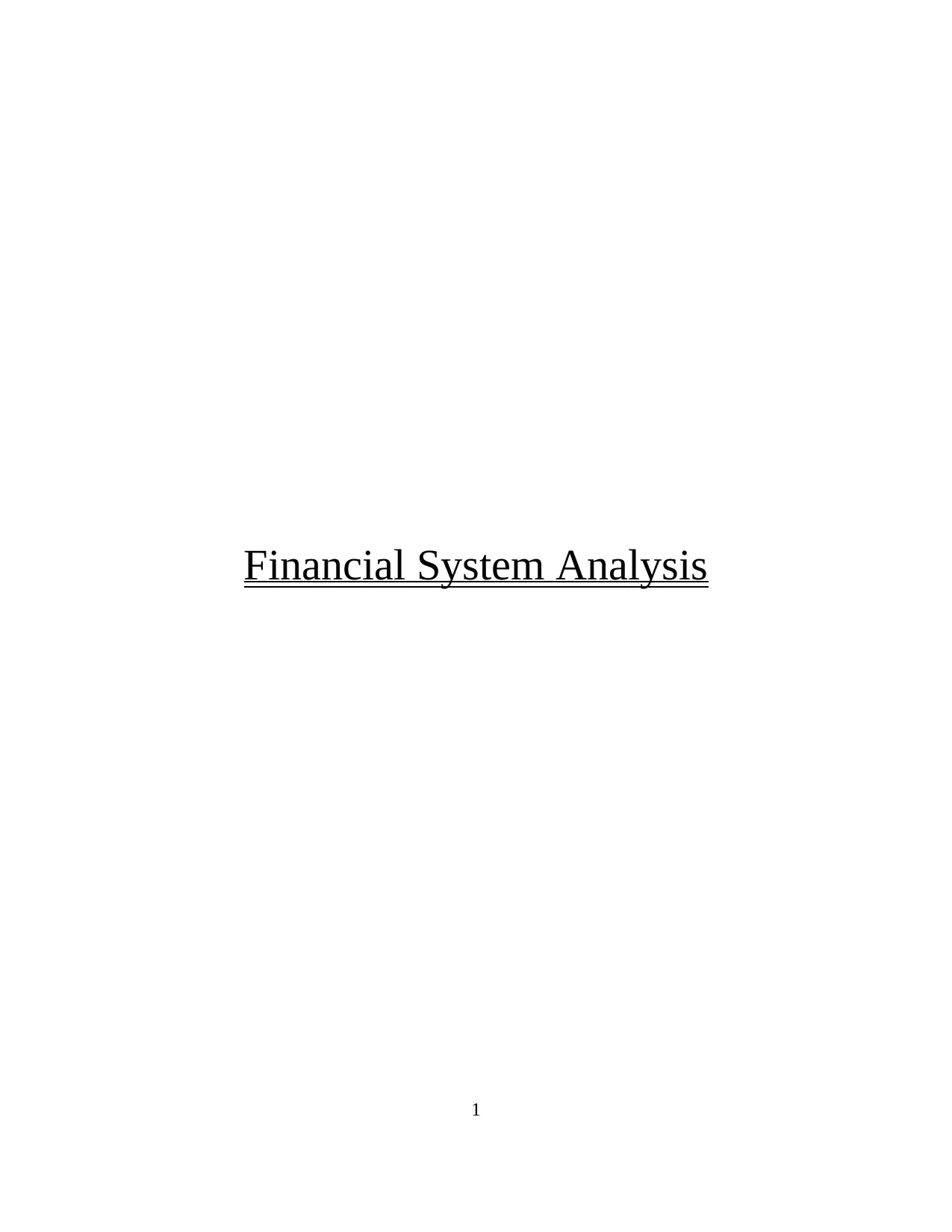
Financial System Analysis
1
1
Paraphrase This Document
Need a fresh take? Get an instant paraphrase of this document with our AI Paraphraser
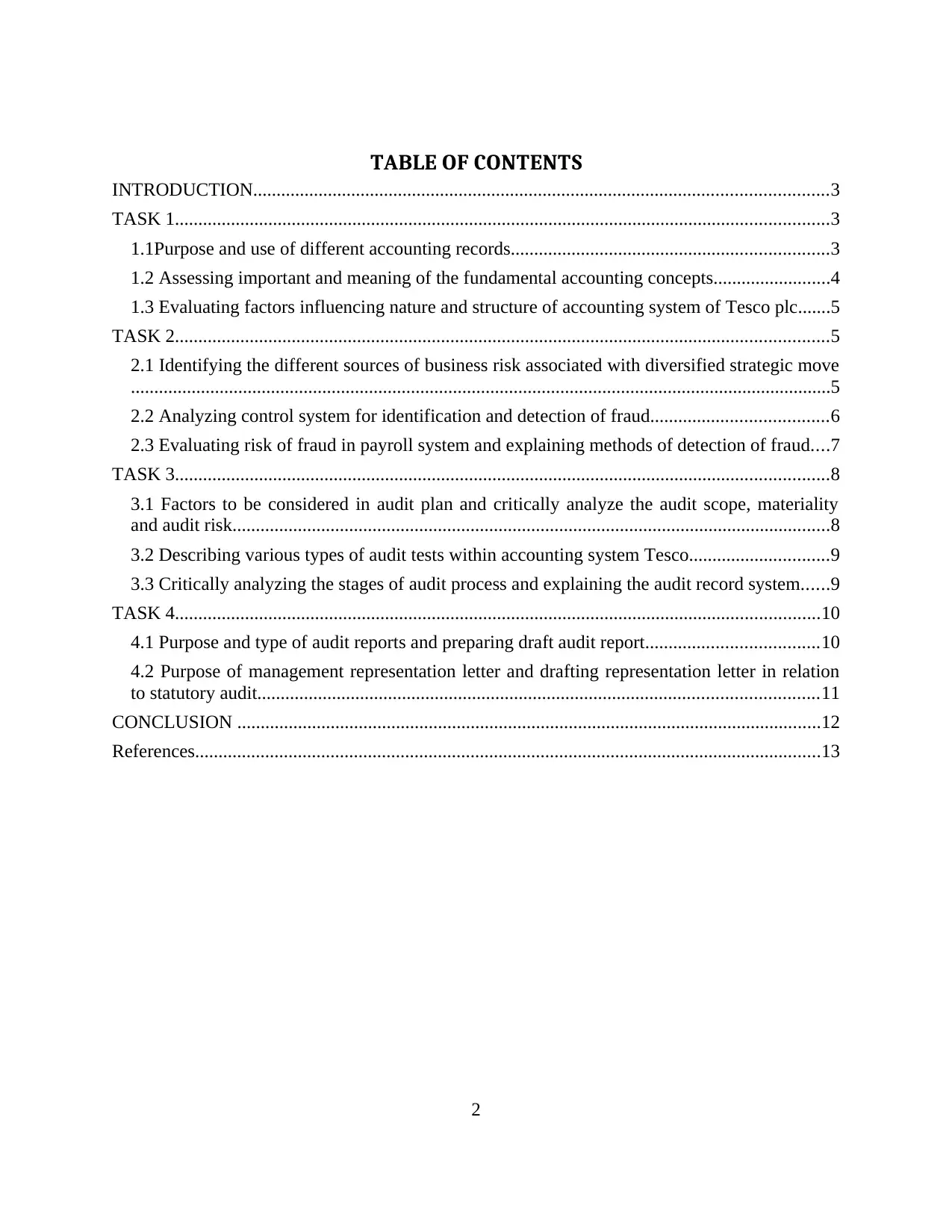
TABLE OF CONTENTS
INTRODUCTION...........................................................................................................................3
TASK 1............................................................................................................................................3
1.1Purpose and use of different accounting records....................................................................3
1.2 Assessing important and meaning of the fundamental accounting concepts.........................4
1.3 Evaluating factors influencing nature and structure of accounting system of Tesco plc.......5
TASK 2............................................................................................................................................5
2.1 Identifying the different sources of business risk associated with diversified strategic move
......................................................................................................................................................5
2.2 Analyzing control system for identification and detection of fraud......................................6
2.3 Evaluating risk of fraud in payroll system and explaining methods of detection of fraud....7
TASK 3............................................................................................................................................8
3.1 Factors to be considered in audit plan and critically analyze the audit scope, materiality
and audit risk................................................................................................................................8
3.2 Describing various types of audit tests within accounting system Tesco..............................9
3.3 Critically analyzing the stages of audit process and explaining the audit record system......9
TASK 4..........................................................................................................................................10
4.1 Purpose and type of audit reports and preparing draft audit report.....................................10
4.2 Purpose of management representation letter and drafting representation letter in relation
to statutory audit........................................................................................................................11
CONCLUSION .............................................................................................................................12
References......................................................................................................................................13
2
INTRODUCTION...........................................................................................................................3
TASK 1............................................................................................................................................3
1.1Purpose and use of different accounting records....................................................................3
1.2 Assessing important and meaning of the fundamental accounting concepts.........................4
1.3 Evaluating factors influencing nature and structure of accounting system of Tesco plc.......5
TASK 2............................................................................................................................................5
2.1 Identifying the different sources of business risk associated with diversified strategic move
......................................................................................................................................................5
2.2 Analyzing control system for identification and detection of fraud......................................6
2.3 Evaluating risk of fraud in payroll system and explaining methods of detection of fraud....7
TASK 3............................................................................................................................................8
3.1 Factors to be considered in audit plan and critically analyze the audit scope, materiality
and audit risk................................................................................................................................8
3.2 Describing various types of audit tests within accounting system Tesco..............................9
3.3 Critically analyzing the stages of audit process and explaining the audit record system......9
TASK 4..........................................................................................................................................10
4.1 Purpose and type of audit reports and preparing draft audit report.....................................10
4.2 Purpose of management representation letter and drafting representation letter in relation
to statutory audit........................................................................................................................11
CONCLUSION .............................................................................................................................12
References......................................................................................................................................13
2
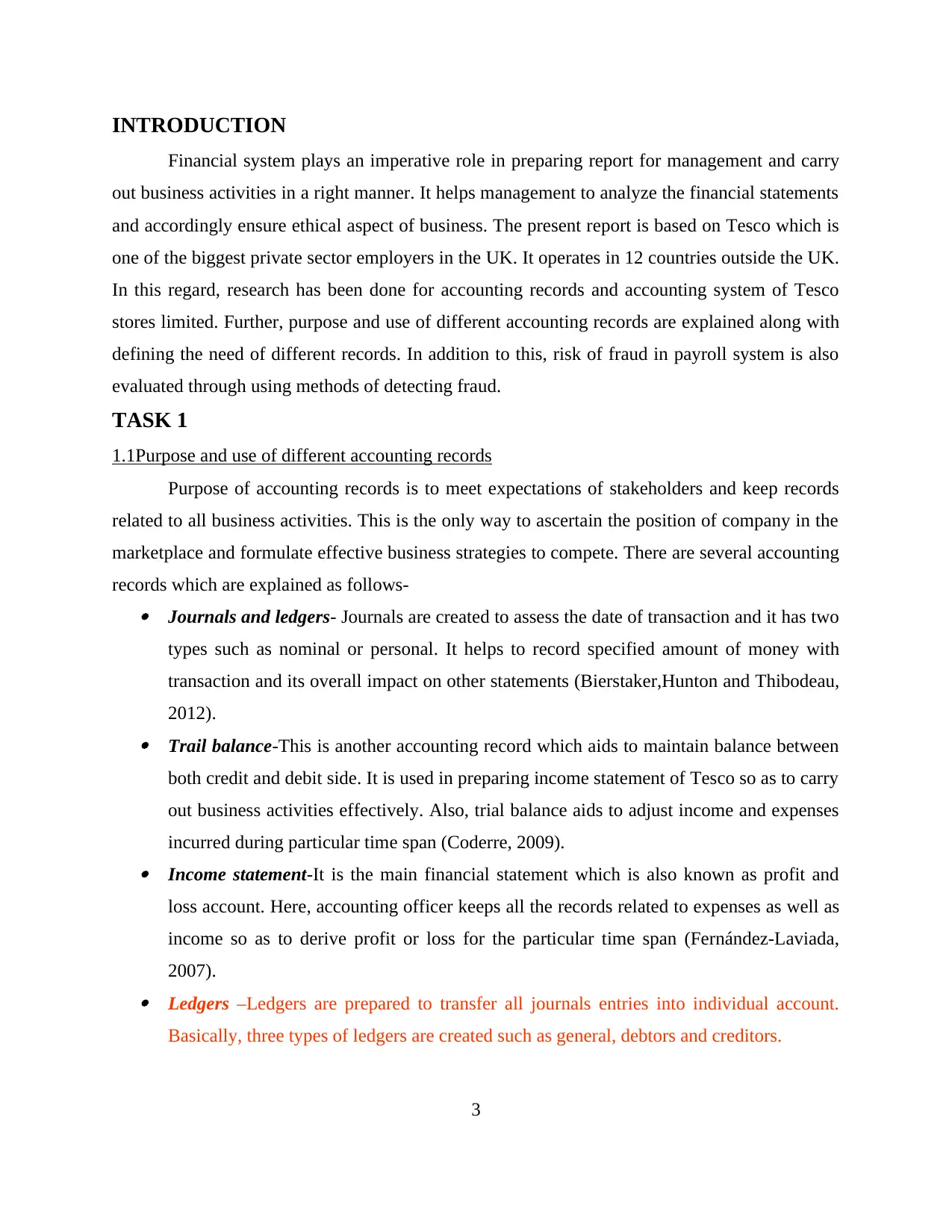
INTRODUCTION
Financial system plays an imperative role in preparing report for management and carry
out business activities in a right manner. It helps management to analyze the financial statements
and accordingly ensure ethical aspect of business. The present report is based on Tesco which is
one of the biggest private sector employers in the UK. It operates in 12 countries outside the UK.
In this regard, research has been done for accounting records and accounting system of Tesco
stores limited. Further, purpose and use of different accounting records are explained along with
defining the need of different records. In addition to this, risk of fraud in payroll system is also
evaluated through using methods of detecting fraud.
TASK 1
1.1Purpose and use of different accounting records
Purpose of accounting records is to meet expectations of stakeholders and keep records
related to all business activities. This is the only way to ascertain the position of company in the
marketplace and formulate effective business strategies to compete. There are several accounting
records which are explained as follows- Journals and ledgers- Journals are created to assess the date of transaction and it has two
types such as nominal or personal. It helps to record specified amount of money with
transaction and its overall impact on other statements (Bierstaker,Hunton and Thibodeau,
2012). Trail balance-This is another accounting record which aids to maintain balance between
both credit and debit side. It is used in preparing income statement of Tesco so as to carry
out business activities effectively. Also, trial balance aids to adjust income and expenses
incurred during particular time span (Coderre, 2009). Income statement-It is the main financial statement which is also known as profit and
loss account. Here, accounting officer keeps all the records related to expenses as well as
income so as to derive profit or loss for the particular time span (Fernández-Laviada,
2007). Ledgers –Ledgers are prepared to transfer all journals entries into individual account.
Basically, three types of ledgers are created such as general, debtors and creditors.
3
Financial system plays an imperative role in preparing report for management and carry
out business activities in a right manner. It helps management to analyze the financial statements
and accordingly ensure ethical aspect of business. The present report is based on Tesco which is
one of the biggest private sector employers in the UK. It operates in 12 countries outside the UK.
In this regard, research has been done for accounting records and accounting system of Tesco
stores limited. Further, purpose and use of different accounting records are explained along with
defining the need of different records. In addition to this, risk of fraud in payroll system is also
evaluated through using methods of detecting fraud.
TASK 1
1.1Purpose and use of different accounting records
Purpose of accounting records is to meet expectations of stakeholders and keep records
related to all business activities. This is the only way to ascertain the position of company in the
marketplace and formulate effective business strategies to compete. There are several accounting
records which are explained as follows- Journals and ledgers- Journals are created to assess the date of transaction and it has two
types such as nominal or personal. It helps to record specified amount of money with
transaction and its overall impact on other statements (Bierstaker,Hunton and Thibodeau,
2012). Trail balance-This is another accounting record which aids to maintain balance between
both credit and debit side. It is used in preparing income statement of Tesco so as to carry
out business activities effectively. Also, trial balance aids to adjust income and expenses
incurred during particular time span (Coderre, 2009). Income statement-It is the main financial statement which is also known as profit and
loss account. Here, accounting officer keeps all the records related to expenses as well as
income so as to derive profit or loss for the particular time span (Fernández-Laviada,
2007). Ledgers –Ledgers are prepared to transfer all journals entries into individual account.
Basically, three types of ledgers are created such as general, debtors and creditors.
3
⊘ This is a preview!⊘
Do you want full access?
Subscribe today to unlock all pages.

Trusted by 1+ million students worldwide
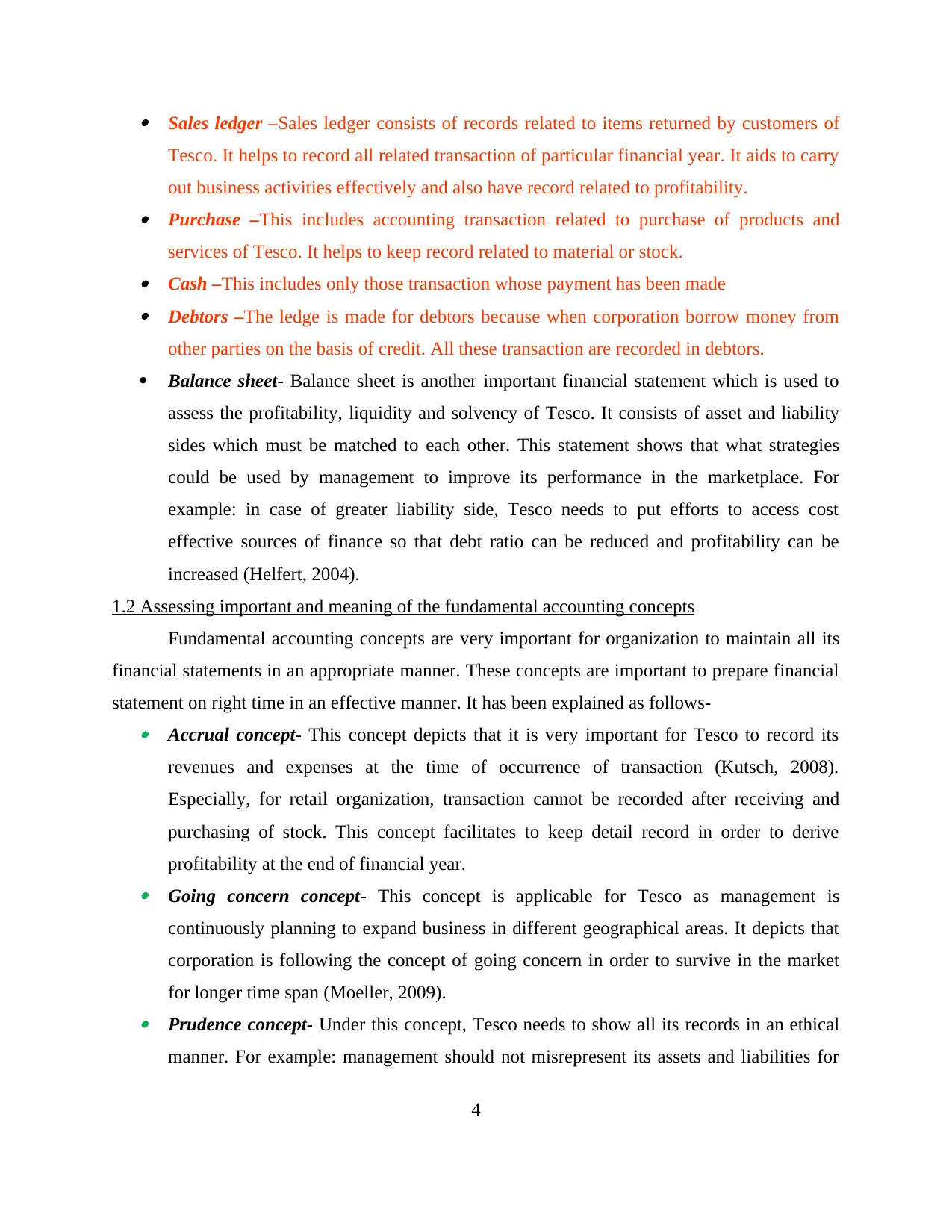
Sales ledger –Sales ledger consists of records related to items returned by customers of
Tesco. It helps to record all related transaction of particular financial year. It aids to carry
out business activities effectively and also have record related to profitability. Purchase –This includes accounting transaction related to purchase of products and
services of Tesco. It helps to keep record related to material or stock. Cash –This includes only those transaction whose payment has been made Debtors –The ledge is made for debtors because when corporation borrow money from
other parties on the basis of credit. All these transaction are recorded in debtors.
Balance sheet- Balance sheet is another important financial statement which is used to
assess the profitability, liquidity and solvency of Tesco. It consists of asset and liability
sides which must be matched to each other. This statement shows that what strategies
could be used by management to improve its performance in the marketplace. For
example: in case of greater liability side, Tesco needs to put efforts to access cost
effective sources of finance so that debt ratio can be reduced and profitability can be
increased (Helfert, 2004).
1.2 Assessing important and meaning of the fundamental accounting concepts
Fundamental accounting concepts are very important for organization to maintain all its
financial statements in an appropriate manner. These concepts are important to prepare financial
statement on right time in an effective manner. It has been explained as follows- Accrual concept- This concept depicts that it is very important for Tesco to record its
revenues and expenses at the time of occurrence of transaction (Kutsch, 2008).
Especially, for retail organization, transaction cannot be recorded after receiving and
purchasing of stock. This concept facilitates to keep detail record in order to derive
profitability at the end of financial year. Going concern concept- This concept is applicable for Tesco as management is
continuously planning to expand business in different geographical areas. It depicts that
corporation is following the concept of going concern in order to survive in the market
for longer time span (Moeller, 2009). Prudence concept- Under this concept, Tesco needs to show all its records in an ethical
manner. For example: management should not misrepresent its assets and liabilities for
4
Tesco. It helps to record all related transaction of particular financial year. It aids to carry
out business activities effectively and also have record related to profitability. Purchase –This includes accounting transaction related to purchase of products and
services of Tesco. It helps to keep record related to material or stock. Cash –This includes only those transaction whose payment has been made Debtors –The ledge is made for debtors because when corporation borrow money from
other parties on the basis of credit. All these transaction are recorded in debtors.
Balance sheet- Balance sheet is another important financial statement which is used to
assess the profitability, liquidity and solvency of Tesco. It consists of asset and liability
sides which must be matched to each other. This statement shows that what strategies
could be used by management to improve its performance in the marketplace. For
example: in case of greater liability side, Tesco needs to put efforts to access cost
effective sources of finance so that debt ratio can be reduced and profitability can be
increased (Helfert, 2004).
1.2 Assessing important and meaning of the fundamental accounting concepts
Fundamental accounting concepts are very important for organization to maintain all its
financial statements in an appropriate manner. These concepts are important to prepare financial
statement on right time in an effective manner. It has been explained as follows- Accrual concept- This concept depicts that it is very important for Tesco to record its
revenues and expenses at the time of occurrence of transaction (Kutsch, 2008).
Especially, for retail organization, transaction cannot be recorded after receiving and
purchasing of stock. This concept facilitates to keep detail record in order to derive
profitability at the end of financial year. Going concern concept- This concept is applicable for Tesco as management is
continuously planning to expand business in different geographical areas. It depicts that
corporation is following the concept of going concern in order to survive in the market
for longer time span (Moeller, 2009). Prudence concept- Under this concept, Tesco needs to show all its records in an ethical
manner. For example: management should not misrepresent its assets and liabilities for
4
Paraphrase This Document
Need a fresh take? Get an instant paraphrase of this document with our AI Paraphraser

the purpose of profitability. It facilitates to operate business in a fair manner and meet
expectations of different stakeholders (Onumah and Krah, 2012).
Consistency concept- It shows that no any changes should be made in accounting system
and corporation should follow the same for the longer time span. However, changes can
be implemented only when new version aids to improve financial results. It will be
feasible to determine the growth and perspective of corporation in the marketplace.
1.3 Evaluating factors influencing nature and structure of accounting system of Tesco plc
There are several factors which influence nature and structure of accounting system of
Tesco. It is because accounting system of company is created with policies formulated by
corporation in accordance with its own feasibility. These factors are as follows- Capital market-It is one of the most imperative factors which affects nature and structure
of accounting system of Tesco. In this regard, economic condition and capital market of
other countries also affect highly because management is continuously planning to
expand (Pickett, 2010). Type of business entity-The type of business entity is also an imperative factor which
decides the structure of accounting policy. Here, Tesco adopts consistency concept which
determines long term survival of the same in the marketplace (Robinson and et.al., 2012).
However, single store cannot be able to derive desired level of output in other country. Legal regulations-Regulatory framework is different from country to country and
economic condition of all countries also not remains the same. For example: different
taxation policy affect the performance of Tesco to a great extent as it leads to reduce the
ratio of profitability (Siddiqui, 2006). Cost of accounting system-It is also an important factor which affects the structure of
accounting system of Tesco. This is because documentation, maintenance and publisher
cost matter a lot. Thus, management need to consider cost for formulation of strategies in
preparting accounting system. It generates cost of accounting which also need to be kept
into mind.
Size of business- It also affects the performance of corporation to a great extent. Being
large scale corporation, Tesco has complexities in maintaining its accounting record.
5
expectations of different stakeholders (Onumah and Krah, 2012).
Consistency concept- It shows that no any changes should be made in accounting system
and corporation should follow the same for the longer time span. However, changes can
be implemented only when new version aids to improve financial results. It will be
feasible to determine the growth and perspective of corporation in the marketplace.
1.3 Evaluating factors influencing nature and structure of accounting system of Tesco plc
There are several factors which influence nature and structure of accounting system of
Tesco. It is because accounting system of company is created with policies formulated by
corporation in accordance with its own feasibility. These factors are as follows- Capital market-It is one of the most imperative factors which affects nature and structure
of accounting system of Tesco. In this regard, economic condition and capital market of
other countries also affect highly because management is continuously planning to
expand (Pickett, 2010). Type of business entity-The type of business entity is also an imperative factor which
decides the structure of accounting policy. Here, Tesco adopts consistency concept which
determines long term survival of the same in the marketplace (Robinson and et.al., 2012).
However, single store cannot be able to derive desired level of output in other country. Legal regulations-Regulatory framework is different from country to country and
economic condition of all countries also not remains the same. For example: different
taxation policy affect the performance of Tesco to a great extent as it leads to reduce the
ratio of profitability (Siddiqui, 2006). Cost of accounting system-It is also an important factor which affects the structure of
accounting system of Tesco. This is because documentation, maintenance and publisher
cost matter a lot. Thus, management need to consider cost for formulation of strategies in
preparting accounting system. It generates cost of accounting which also need to be kept
into mind.
Size of business- It also affects the performance of corporation to a great extent. Being
large scale corporation, Tesco has complexities in maintaining its accounting record.
5

Therefore, management needs to ensure that it follows similar structure of accounting
policies for all its outlets (Stefan and et.al., 2013).
TASK 2
2.1 Identifying the different sources of business risk associated with diversified strategic move
Business risk is common thing and it is always associated with success and growth of the
same. Especially at the time of diversification, corporation takes risk as it enters in new market
with uncertainty. Owing to this, different sources of business risk must be considered which are
explained as follows- Risk of fraud-It is the most common risk which could be faced by Tesco. It is because
payroll system and other related regulations are different in each country where
management may face issue in its payroll system (Tarantino, 2010). Financial risk-Global expansion is not easy task for any corporation as financial stability
must be there. However, Tesco operates at large scale and has availability of financial
resources but because of currency fluctuation, unfavorable economic condition of
countries can create problem (Tchankova, 2002). Changing preferences of buyers-In current era, customers' need and preferences are kept
on changing because of their lifestyle, education, income and occupation. Owing to this,
Tesco can face barriers in maintaining high sales turnover and increasing customer base. Changing marketing conditions-The scenario of marketing also changing at rapid speed
because of innovation and creation of products and services (Alam and Brown, 2006).
Owing to this, Tesco can have issue related to tough competition. This in turn affects
profitability and cost of production. At this juncture, company creates additional cost to
create competitive edge where rate of return may go down. Hence, this is also one of the
potential risk factors.
Increased global marketing-Under this, number of competitors are expanding
themselves at global level. It increases competition for Tesco so management need to
take right action to create distinctive image in the marketplace.
2.2 Analyzing control system for identification and detection of fraud
The control system is established by organization in order to reduce the risk level to a
great extent. In this regard, management ensures that employees are performing their duties in
6
policies for all its outlets (Stefan and et.al., 2013).
TASK 2
2.1 Identifying the different sources of business risk associated with diversified strategic move
Business risk is common thing and it is always associated with success and growth of the
same. Especially at the time of diversification, corporation takes risk as it enters in new market
with uncertainty. Owing to this, different sources of business risk must be considered which are
explained as follows- Risk of fraud-It is the most common risk which could be faced by Tesco. It is because
payroll system and other related regulations are different in each country where
management may face issue in its payroll system (Tarantino, 2010). Financial risk-Global expansion is not easy task for any corporation as financial stability
must be there. However, Tesco operates at large scale and has availability of financial
resources but because of currency fluctuation, unfavorable economic condition of
countries can create problem (Tchankova, 2002). Changing preferences of buyers-In current era, customers' need and preferences are kept
on changing because of their lifestyle, education, income and occupation. Owing to this,
Tesco can face barriers in maintaining high sales turnover and increasing customer base. Changing marketing conditions-The scenario of marketing also changing at rapid speed
because of innovation and creation of products and services (Alam and Brown, 2006).
Owing to this, Tesco can have issue related to tough competition. This in turn affects
profitability and cost of production. At this juncture, company creates additional cost to
create competitive edge where rate of return may go down. Hence, this is also one of the
potential risk factors.
Increased global marketing-Under this, number of competitors are expanding
themselves at global level. It increases competition for Tesco so management need to
take right action to create distinctive image in the marketplace.
2.2 Analyzing control system for identification and detection of fraud
The control system is established by organization in order to reduce the risk level to a
great extent. In this regard, management ensures that employees are performing their duties in
6
⊘ This is a preview!⊘
Do you want full access?
Subscribe today to unlock all pages.

Trusted by 1+ million students worldwide
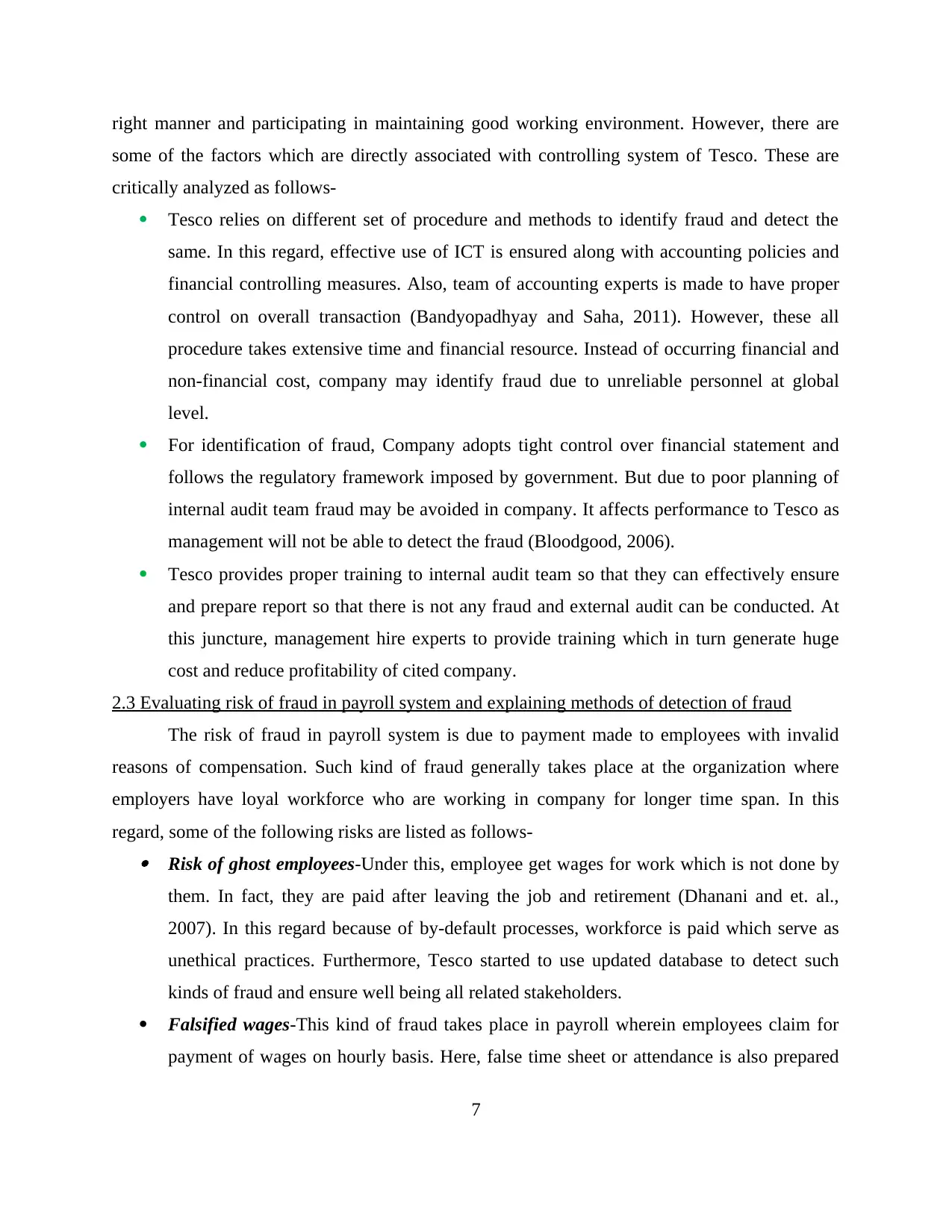
right manner and participating in maintaining good working environment. However, there are
some of the factors which are directly associated with controlling system of Tesco. These are
critically analyzed as follows-
Tesco relies on different set of procedure and methods to identify fraud and detect the
same. In this regard, effective use of ICT is ensured along with accounting policies and
financial controlling measures. Also, team of accounting experts is made to have proper
control on overall transaction (Bandyopadhyay and Saha, 2011). However, these all
procedure takes extensive time and financial resource. Instead of occurring financial and
non-financial cost, company may identify fraud due to unreliable personnel at global
level.
For identification of fraud, Company adopts tight control over financial statement and
follows the regulatory framework imposed by government. But due to poor planning of
internal audit team fraud may be avoided in company. It affects performance to Tesco as
management will not be able to detect the fraud (Bloodgood, 2006).
Tesco provides proper training to internal audit team so that they can effectively ensure
and prepare report so that there is not any fraud and external audit can be conducted. At
this juncture, management hire experts to provide training which in turn generate huge
cost and reduce profitability of cited company.
2.3 Evaluating risk of fraud in payroll system and explaining methods of detection of fraud
The risk of fraud in payroll system is due to payment made to employees with invalid
reasons of compensation. Such kind of fraud generally takes place at the organization where
employers have loyal workforce who are working in company for longer time span. In this
regard, some of the following risks are listed as follows- Risk of ghost employees-Under this, employee get wages for work which is not done by
them. In fact, they are paid after leaving the job and retirement (Dhanani and et. al.,
2007). In this regard because of by-default processes, workforce is paid which serve as
unethical practices. Furthermore, Tesco started to use updated database to detect such
kinds of fraud and ensure well being all related stakeholders.
Falsified wages-This kind of fraud takes place in payroll wherein employees claim for
payment of wages on hourly basis. Here, false time sheet or attendance is also prepared
7
some of the factors which are directly associated with controlling system of Tesco. These are
critically analyzed as follows-
Tesco relies on different set of procedure and methods to identify fraud and detect the
same. In this regard, effective use of ICT is ensured along with accounting policies and
financial controlling measures. Also, team of accounting experts is made to have proper
control on overall transaction (Bandyopadhyay and Saha, 2011). However, these all
procedure takes extensive time and financial resource. Instead of occurring financial and
non-financial cost, company may identify fraud due to unreliable personnel at global
level.
For identification of fraud, Company adopts tight control over financial statement and
follows the regulatory framework imposed by government. But due to poor planning of
internal audit team fraud may be avoided in company. It affects performance to Tesco as
management will not be able to detect the fraud (Bloodgood, 2006).
Tesco provides proper training to internal audit team so that they can effectively ensure
and prepare report so that there is not any fraud and external audit can be conducted. At
this juncture, management hire experts to provide training which in turn generate huge
cost and reduce profitability of cited company.
2.3 Evaluating risk of fraud in payroll system and explaining methods of detection of fraud
The risk of fraud in payroll system is due to payment made to employees with invalid
reasons of compensation. Such kind of fraud generally takes place at the organization where
employers have loyal workforce who are working in company for longer time span. In this
regard, some of the following risks are listed as follows- Risk of ghost employees-Under this, employee get wages for work which is not done by
them. In fact, they are paid after leaving the job and retirement (Dhanani and et. al.,
2007). In this regard because of by-default processes, workforce is paid which serve as
unethical practices. Furthermore, Tesco started to use updated database to detect such
kinds of fraud and ensure well being all related stakeholders.
Falsified wages-This kind of fraud takes place in payroll wherein employees claim for
payment of wages on hourly basis. Here, false time sheet or attendance is also prepared
7
Paraphrase This Document
Need a fresh take? Get an instant paraphrase of this document with our AI Paraphraser
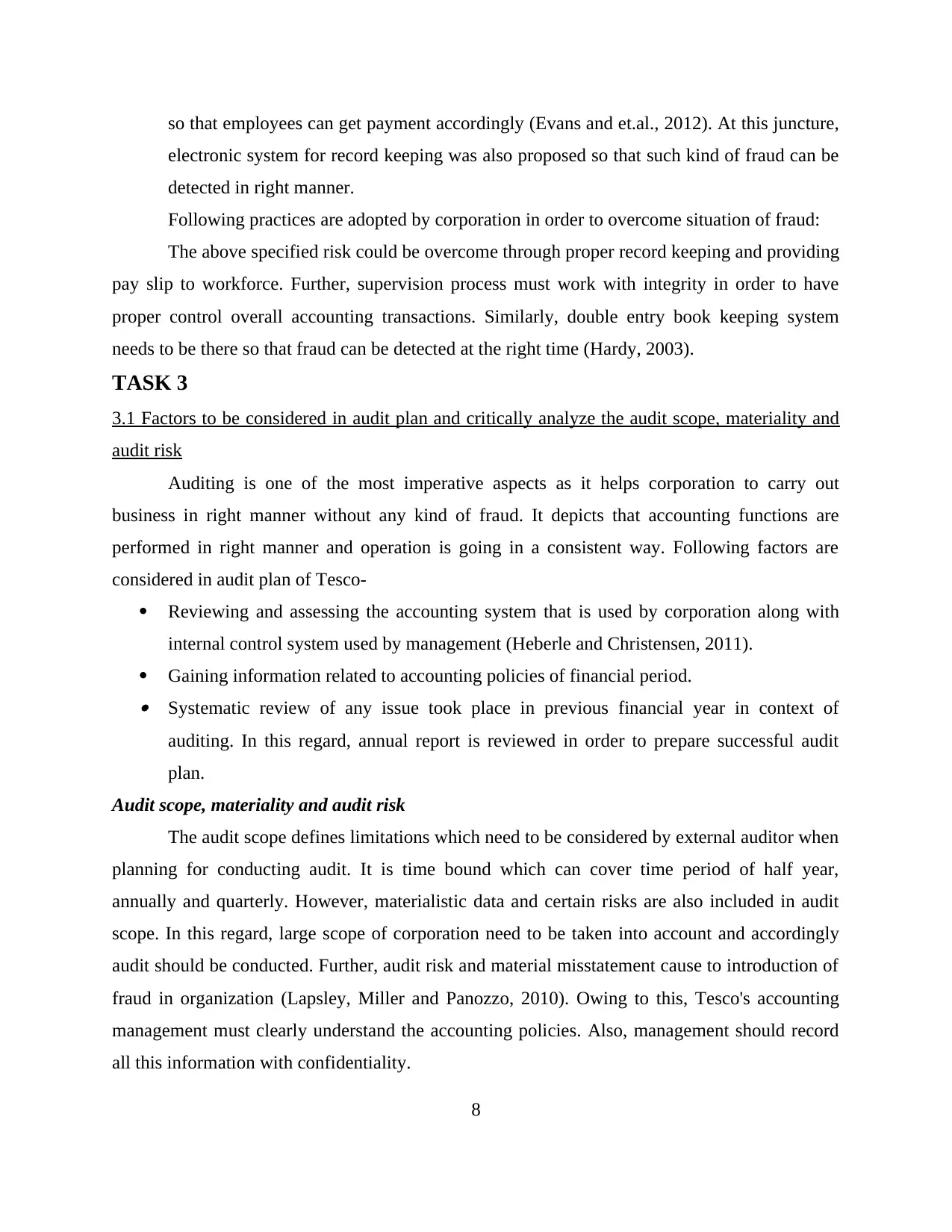
so that employees can get payment accordingly (Evans and et.al., 2012). At this juncture,
electronic system for record keeping was also proposed so that such kind of fraud can be
detected in right manner.
Following practices are adopted by corporation in order to overcome situation of fraud:
The above specified risk could be overcome through proper record keeping and providing
pay slip to workforce. Further, supervision process must work with integrity in order to have
proper control overall accounting transactions. Similarly, double entry book keeping system
needs to be there so that fraud can be detected at the right time (Hardy, 2003).
TASK 3
3.1 Factors to be considered in audit plan and critically analyze the audit scope, materiality and
audit risk
Auditing is one of the most imperative aspects as it helps corporation to carry out
business in right manner without any kind of fraud. It depicts that accounting functions are
performed in right manner and operation is going in a consistent way. Following factors are
considered in audit plan of Tesco-
Reviewing and assessing the accounting system that is used by corporation along with
internal control system used by management (Heberle and Christensen, 2011).
Gaining information related to accounting policies of financial period. Systematic review of any issue took place in previous financial year in context of
auditing. In this regard, annual report is reviewed in order to prepare successful audit
plan.
Audit scope, materiality and audit risk
The audit scope defines limitations which need to be considered by external auditor when
planning for conducting audit. It is time bound which can cover time period of half year,
annually and quarterly. However, materialistic data and certain risks are also included in audit
scope. In this regard, large scope of corporation need to be taken into account and accordingly
audit should be conducted. Further, audit risk and material misstatement cause to introduction of
fraud in organization (Lapsley, Miller and Panozzo, 2010). Owing to this, Tesco's accounting
management must clearly understand the accounting policies. Also, management should record
all this information with confidentiality.
8
electronic system for record keeping was also proposed so that such kind of fraud can be
detected in right manner.
Following practices are adopted by corporation in order to overcome situation of fraud:
The above specified risk could be overcome through proper record keeping and providing
pay slip to workforce. Further, supervision process must work with integrity in order to have
proper control overall accounting transactions. Similarly, double entry book keeping system
needs to be there so that fraud can be detected at the right time (Hardy, 2003).
TASK 3
3.1 Factors to be considered in audit plan and critically analyze the audit scope, materiality and
audit risk
Auditing is one of the most imperative aspects as it helps corporation to carry out
business in right manner without any kind of fraud. It depicts that accounting functions are
performed in right manner and operation is going in a consistent way. Following factors are
considered in audit plan of Tesco-
Reviewing and assessing the accounting system that is used by corporation along with
internal control system used by management (Heberle and Christensen, 2011).
Gaining information related to accounting policies of financial period. Systematic review of any issue took place in previous financial year in context of
auditing. In this regard, annual report is reviewed in order to prepare successful audit
plan.
Audit scope, materiality and audit risk
The audit scope defines limitations which need to be considered by external auditor when
planning for conducting audit. It is time bound which can cover time period of half year,
annually and quarterly. However, materialistic data and certain risks are also included in audit
scope. In this regard, large scope of corporation need to be taken into account and accordingly
audit should be conducted. Further, audit risk and material misstatement cause to introduction of
fraud in organization (Lapsley, Miller and Panozzo, 2010). Owing to this, Tesco's accounting
management must clearly understand the accounting policies. Also, management should record
all this information with confidentiality.
8
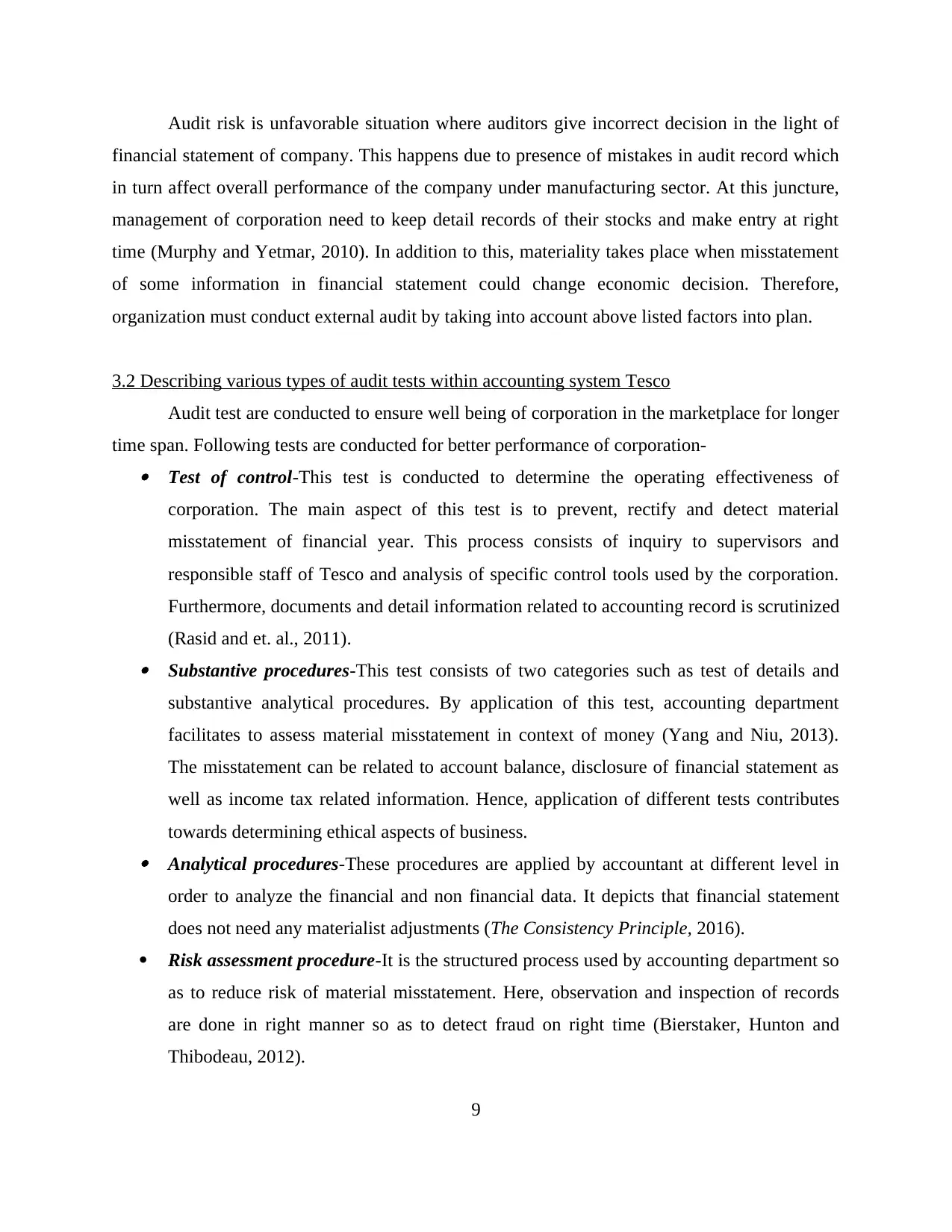
Audit risk is unfavorable situation where auditors give incorrect decision in the light of
financial statement of company. This happens due to presence of mistakes in audit record which
in turn affect overall performance of the company under manufacturing sector. At this juncture,
management of corporation need to keep detail records of their stocks and make entry at right
time (Murphy and Yetmar, 2010). In addition to this, materiality takes place when misstatement
of some information in financial statement could change economic decision. Therefore,
organization must conduct external audit by taking into account above listed factors into plan.
3.2 Describing various types of audit tests within accounting system Tesco
Audit test are conducted to ensure well being of corporation in the marketplace for longer
time span. Following tests are conducted for better performance of corporation- Test of control-This test is conducted to determine the operating effectiveness of
corporation. The main aspect of this test is to prevent, rectify and detect material
misstatement of financial year. This process consists of inquiry to supervisors and
responsible staff of Tesco and analysis of specific control tools used by the corporation.
Furthermore, documents and detail information related to accounting record is scrutinized
(Rasid and et. al., 2011). Substantive procedures-This test consists of two categories such as test of details and
substantive analytical procedures. By application of this test, accounting department
facilitates to assess material misstatement in context of money (Yang and Niu, 2013).
The misstatement can be related to account balance, disclosure of financial statement as
well as income tax related information. Hence, application of different tests contributes
towards determining ethical aspects of business. Analytical procedures-These procedures are applied by accountant at different level in
order to analyze the financial and non financial data. It depicts that financial statement
does not need any materialist adjustments (The Consistency Principle, 2016).
Risk assessment procedure-It is the structured process used by accounting department so
as to reduce risk of material misstatement. Here, observation and inspection of records
are done in right manner so as to detect fraud on right time (Bierstaker, Hunton and
Thibodeau, 2012).
9
financial statement of company. This happens due to presence of mistakes in audit record which
in turn affect overall performance of the company under manufacturing sector. At this juncture,
management of corporation need to keep detail records of their stocks and make entry at right
time (Murphy and Yetmar, 2010). In addition to this, materiality takes place when misstatement
of some information in financial statement could change economic decision. Therefore,
organization must conduct external audit by taking into account above listed factors into plan.
3.2 Describing various types of audit tests within accounting system Tesco
Audit test are conducted to ensure well being of corporation in the marketplace for longer
time span. Following tests are conducted for better performance of corporation- Test of control-This test is conducted to determine the operating effectiveness of
corporation. The main aspect of this test is to prevent, rectify and detect material
misstatement of financial year. This process consists of inquiry to supervisors and
responsible staff of Tesco and analysis of specific control tools used by the corporation.
Furthermore, documents and detail information related to accounting record is scrutinized
(Rasid and et. al., 2011). Substantive procedures-This test consists of two categories such as test of details and
substantive analytical procedures. By application of this test, accounting department
facilitates to assess material misstatement in context of money (Yang and Niu, 2013).
The misstatement can be related to account balance, disclosure of financial statement as
well as income tax related information. Hence, application of different tests contributes
towards determining ethical aspects of business. Analytical procedures-These procedures are applied by accountant at different level in
order to analyze the financial and non financial data. It depicts that financial statement
does not need any materialist adjustments (The Consistency Principle, 2016).
Risk assessment procedure-It is the structured process used by accounting department so
as to reduce risk of material misstatement. Here, observation and inspection of records
are done in right manner so as to detect fraud on right time (Bierstaker, Hunton and
Thibodeau, 2012).
9
⊘ This is a preview!⊘
Do you want full access?
Subscribe today to unlock all pages.

Trusted by 1+ million students worldwide
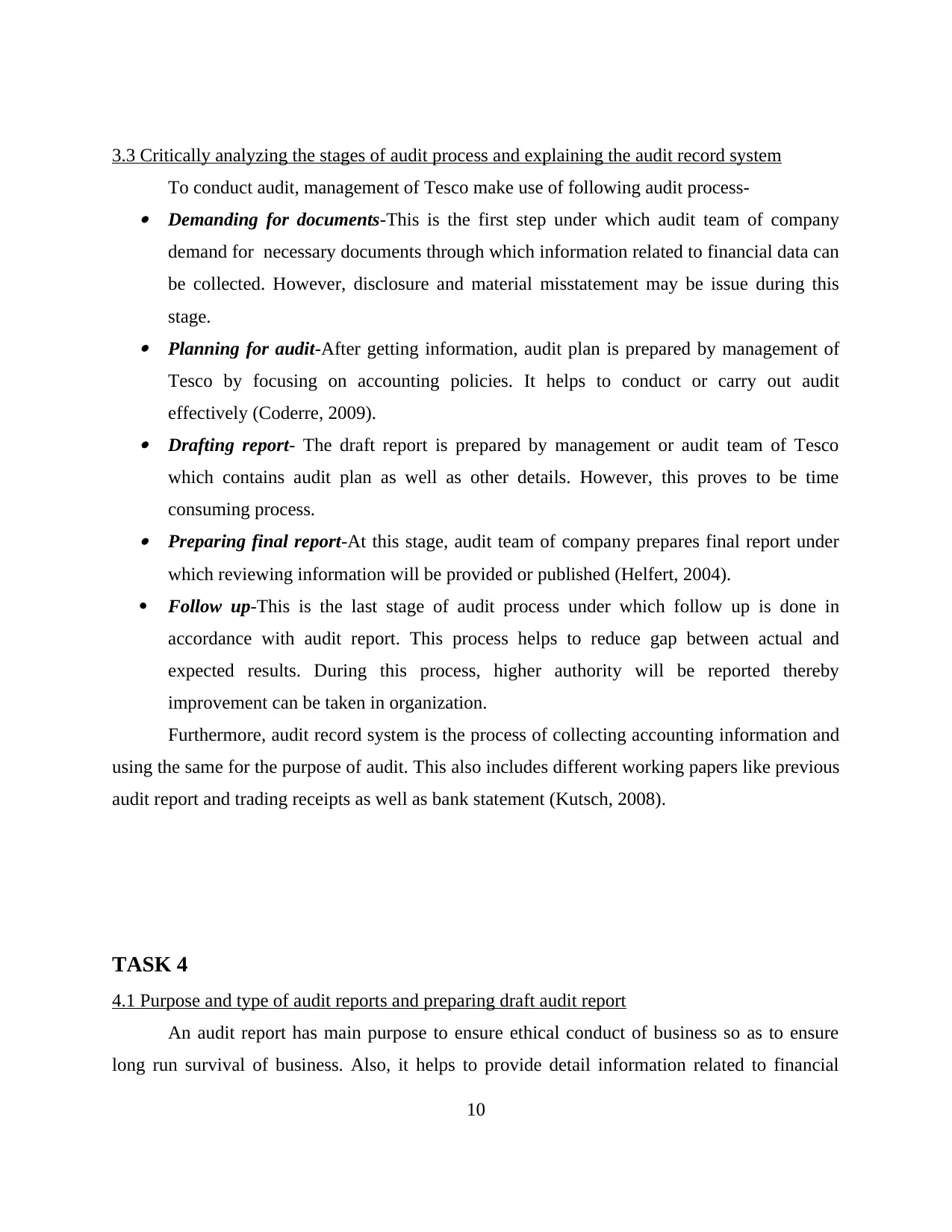
3.3 Critically analyzing the stages of audit process and explaining the audit record system
To conduct audit, management of Tesco make use of following audit process- Demanding for documents-This is the first step under which audit team of company
demand for necessary documents through which information related to financial data can
be collected. However, disclosure and material misstatement may be issue during this
stage. Planning for audit-After getting information, audit plan is prepared by management of
Tesco by focusing on accounting policies. It helps to conduct or carry out audit
effectively (Coderre, 2009). Drafting report- The draft report is prepared by management or audit team of Tesco
which contains audit plan as well as other details. However, this proves to be time
consuming process. Preparing final report-At this stage, audit team of company prepares final report under
which reviewing information will be provided or published (Helfert, 2004).
Follow up-This is the last stage of audit process under which follow up is done in
accordance with audit report. This process helps to reduce gap between actual and
expected results. During this process, higher authority will be reported thereby
improvement can be taken in organization.
Furthermore, audit record system is the process of collecting accounting information and
using the same for the purpose of audit. This also includes different working papers like previous
audit report and trading receipts as well as bank statement (Kutsch, 2008).
TASK 4
4.1 Purpose and type of audit reports and preparing draft audit report
An audit report has main purpose to ensure ethical conduct of business so as to ensure
long run survival of business. Also, it helps to provide detail information related to financial
10
To conduct audit, management of Tesco make use of following audit process- Demanding for documents-This is the first step under which audit team of company
demand for necessary documents through which information related to financial data can
be collected. However, disclosure and material misstatement may be issue during this
stage. Planning for audit-After getting information, audit plan is prepared by management of
Tesco by focusing on accounting policies. It helps to conduct or carry out audit
effectively (Coderre, 2009). Drafting report- The draft report is prepared by management or audit team of Tesco
which contains audit plan as well as other details. However, this proves to be time
consuming process. Preparing final report-At this stage, audit team of company prepares final report under
which reviewing information will be provided or published (Helfert, 2004).
Follow up-This is the last stage of audit process under which follow up is done in
accordance with audit report. This process helps to reduce gap between actual and
expected results. During this process, higher authority will be reported thereby
improvement can be taken in organization.
Furthermore, audit record system is the process of collecting accounting information and
using the same for the purpose of audit. This also includes different working papers like previous
audit report and trading receipts as well as bank statement (Kutsch, 2008).
TASK 4
4.1 Purpose and type of audit reports and preparing draft audit report
An audit report has main purpose to ensure ethical conduct of business so as to ensure
long run survival of business. Also, it helps to provide detail information related to financial
10
Paraphrase This Document
Need a fresh take? Get an instant paraphrase of this document with our AI Paraphraser
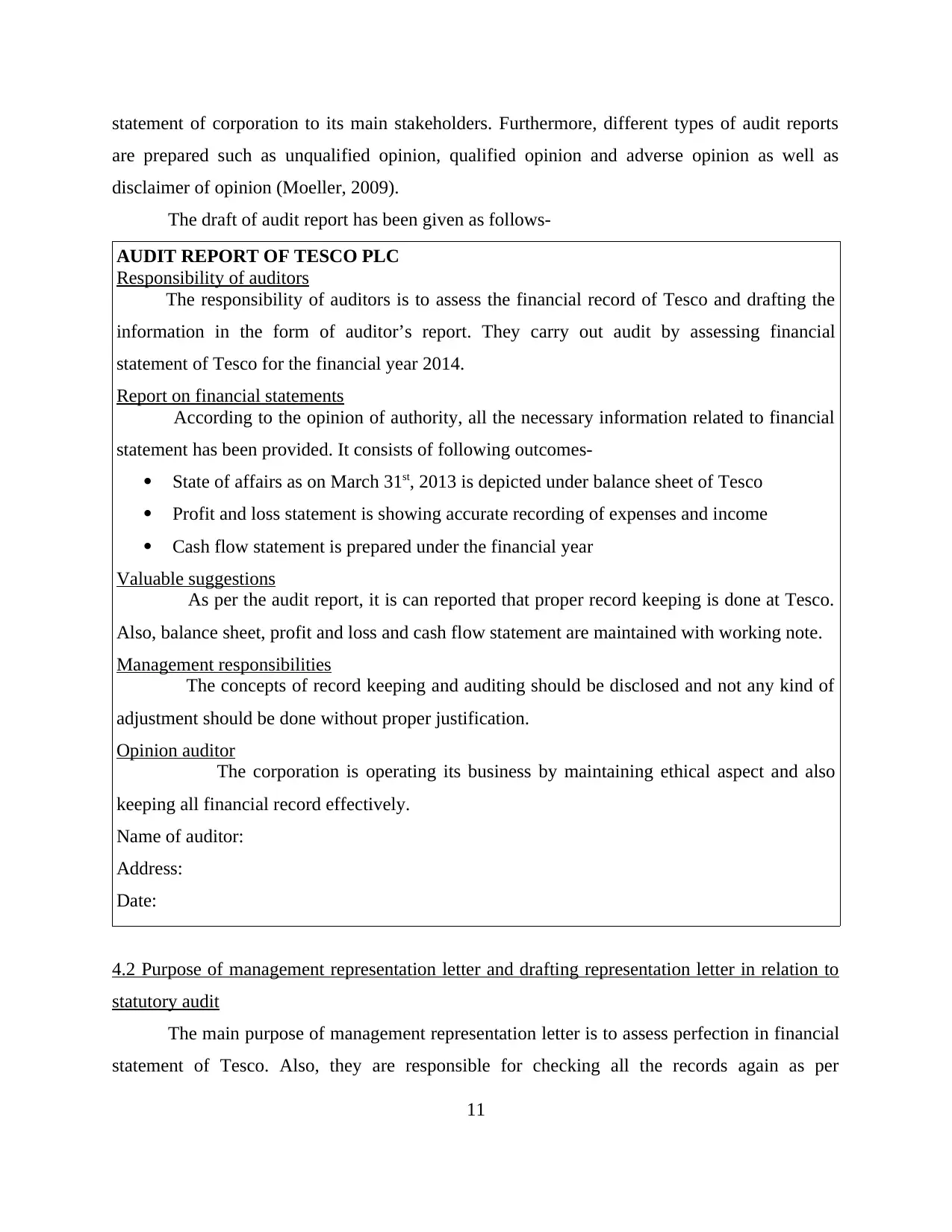
statement of corporation to its main stakeholders. Furthermore, different types of audit reports
are prepared such as unqualified opinion, qualified opinion and adverse opinion as well as
disclaimer of opinion (Moeller, 2009).
The draft of audit report has been given as follows-
AUDIT REPORT OF TESCO PLC
Responsibility of auditors
The responsibility of auditors is to assess the financial record of Tesco and drafting the
information in the form of auditor’s report. They carry out audit by assessing financial
statement of Tesco for the financial year 2014.
Report on financial statements
According to the opinion of authority, all the necessary information related to financial
statement has been provided. It consists of following outcomes-
State of affairs as on March 31st, 2013 is depicted under balance sheet of Tesco
Profit and loss statement is showing accurate recording of expenses and income
Cash flow statement is prepared under the financial year
Valuable suggestions
As per the audit report, it is can reported that proper record keeping is done at Tesco.
Also, balance sheet, profit and loss and cash flow statement are maintained with working note.
Management responsibilities
The concepts of record keeping and auditing should be disclosed and not any kind of
adjustment should be done without proper justification.
Opinion auditor
The corporation is operating its business by maintaining ethical aspect and also
keeping all financial record effectively.
Name of auditor:
Address:
Date:
4.2 Purpose of management representation letter and drafting representation letter in relation to
statutory audit
The main purpose of management representation letter is to assess perfection in financial
statement of Tesco. Also, they are responsible for checking all the records again as per
11
are prepared such as unqualified opinion, qualified opinion and adverse opinion as well as
disclaimer of opinion (Moeller, 2009).
The draft of audit report has been given as follows-
AUDIT REPORT OF TESCO PLC
Responsibility of auditors
The responsibility of auditors is to assess the financial record of Tesco and drafting the
information in the form of auditor’s report. They carry out audit by assessing financial
statement of Tesco for the financial year 2014.
Report on financial statements
According to the opinion of authority, all the necessary information related to financial
statement has been provided. It consists of following outcomes-
State of affairs as on March 31st, 2013 is depicted under balance sheet of Tesco
Profit and loss statement is showing accurate recording of expenses and income
Cash flow statement is prepared under the financial year
Valuable suggestions
As per the audit report, it is can reported that proper record keeping is done at Tesco.
Also, balance sheet, profit and loss and cash flow statement are maintained with working note.
Management responsibilities
The concepts of record keeping and auditing should be disclosed and not any kind of
adjustment should be done without proper justification.
Opinion auditor
The corporation is operating its business by maintaining ethical aspect and also
keeping all financial record effectively.
Name of auditor:
Address:
Date:
4.2 Purpose of management representation letter and drafting representation letter in relation to
statutory audit
The main purpose of management representation letter is to assess perfection in financial
statement of Tesco. Also, they are responsible for checking all the records again as per
11
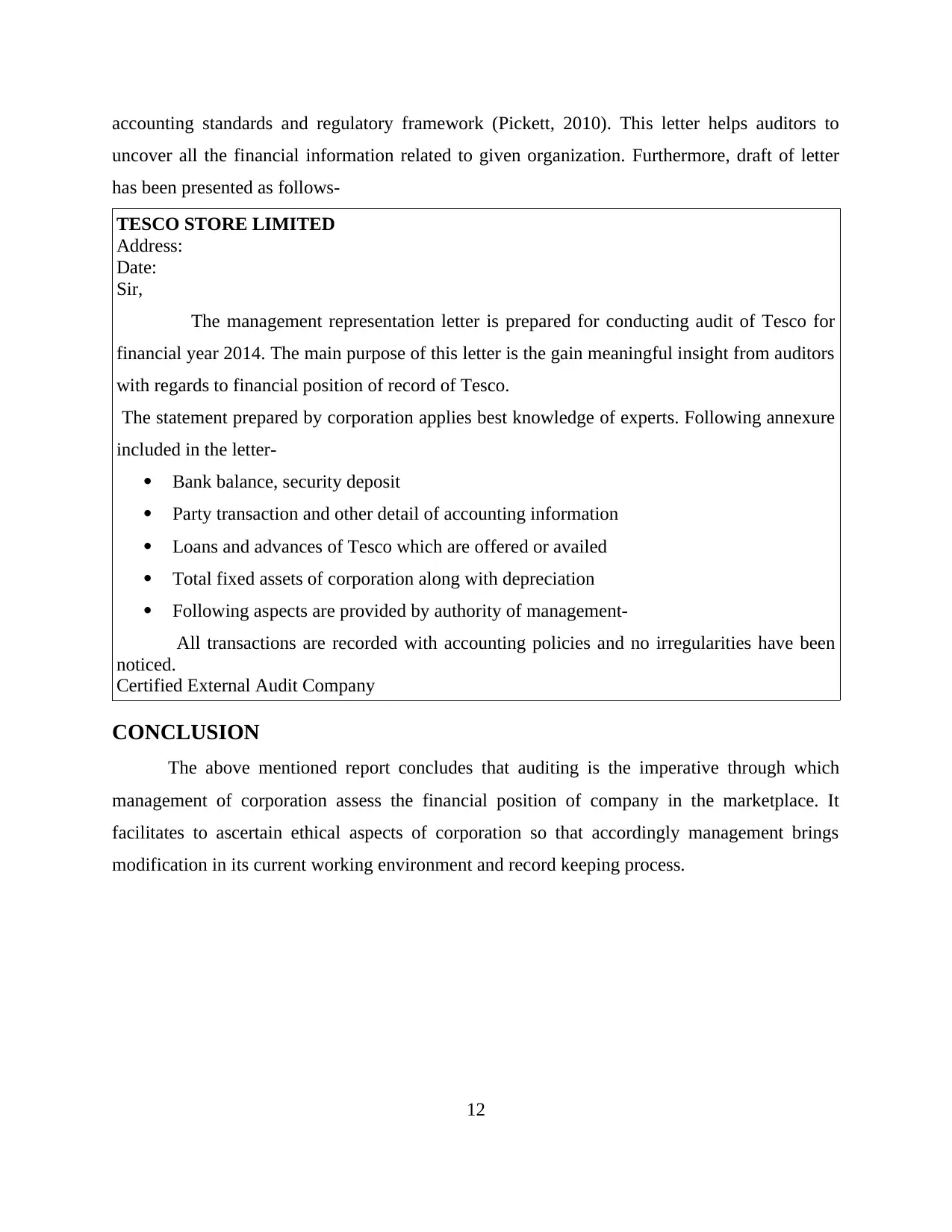
accounting standards and regulatory framework (Pickett, 2010). This letter helps auditors to
uncover all the financial information related to given organization. Furthermore, draft of letter
has been presented as follows-
TESCO STORE LIMITED
Address:
Date:
Sir,
The management representation letter is prepared for conducting audit of Tesco for
financial year 2014. The main purpose of this letter is the gain meaningful insight from auditors
with regards to financial position of record of Tesco.
The statement prepared by corporation applies best knowledge of experts. Following annexure
included in the letter-
Bank balance, security deposit
Party transaction and other detail of accounting information
Loans and advances of Tesco which are offered or availed
Total fixed assets of corporation along with depreciation
Following aspects are provided by authority of management-
All transactions are recorded with accounting policies and no irregularities have been
noticed.
Certified External Audit Company
CONCLUSION
The above mentioned report concludes that auditing is the imperative through which
management of corporation assess the financial position of company in the marketplace. It
facilitates to ascertain ethical aspects of corporation so that accordingly management brings
modification in its current working environment and record keeping process.
12
uncover all the financial information related to given organization. Furthermore, draft of letter
has been presented as follows-
TESCO STORE LIMITED
Address:
Date:
Sir,
The management representation letter is prepared for conducting audit of Tesco for
financial year 2014. The main purpose of this letter is the gain meaningful insight from auditors
with regards to financial position of record of Tesco.
The statement prepared by corporation applies best knowledge of experts. Following annexure
included in the letter-
Bank balance, security deposit
Party transaction and other detail of accounting information
Loans and advances of Tesco which are offered or availed
Total fixed assets of corporation along with depreciation
Following aspects are provided by authority of management-
All transactions are recorded with accounting policies and no irregularities have been
noticed.
Certified External Audit Company
CONCLUSION
The above mentioned report concludes that auditing is the imperative through which
management of corporation assess the financial position of company in the marketplace. It
facilitates to ascertain ethical aspects of corporation so that accordingly management brings
modification in its current working environment and record keeping process.
12
⊘ This is a preview!⊘
Do you want full access?
Subscribe today to unlock all pages.

Trusted by 1+ million students worldwide
1 out of 14
Related Documents
Your All-in-One AI-Powered Toolkit for Academic Success.
+13062052269
info@desklib.com
Available 24*7 on WhatsApp / Email
![[object Object]](/_next/static/media/star-bottom.7253800d.svg)
Unlock your academic potential
Copyright © 2020–2025 A2Z Services. All Rights Reserved. Developed and managed by ZUCOL.





